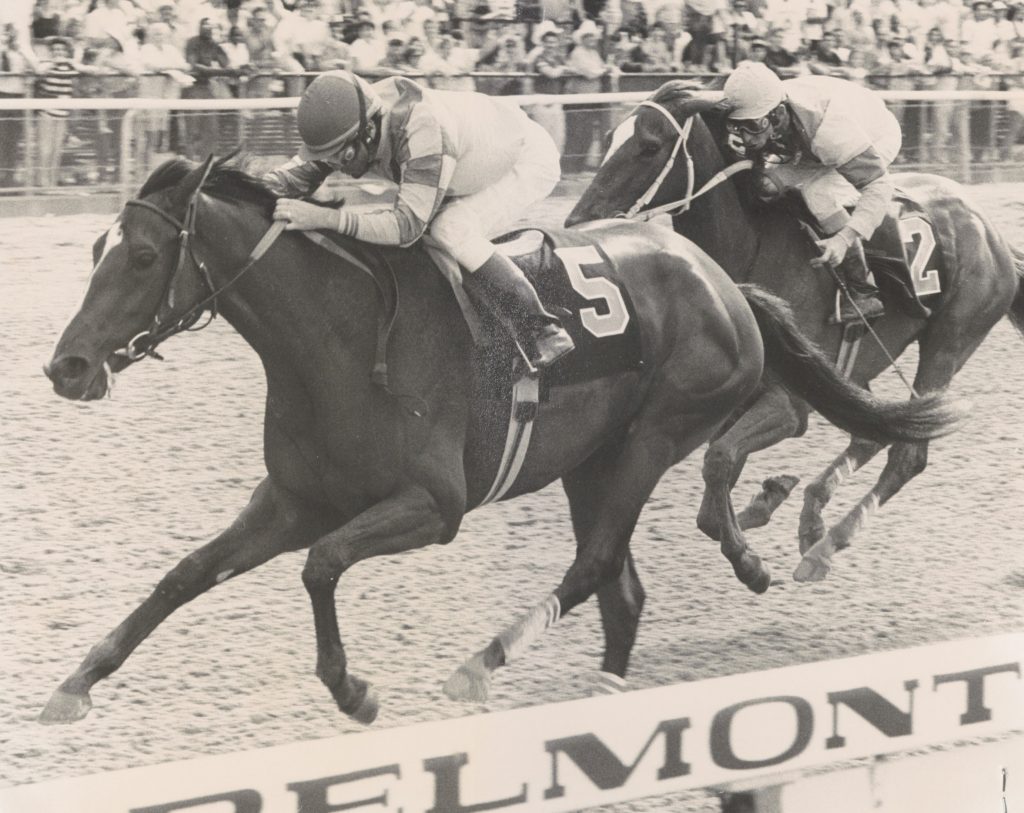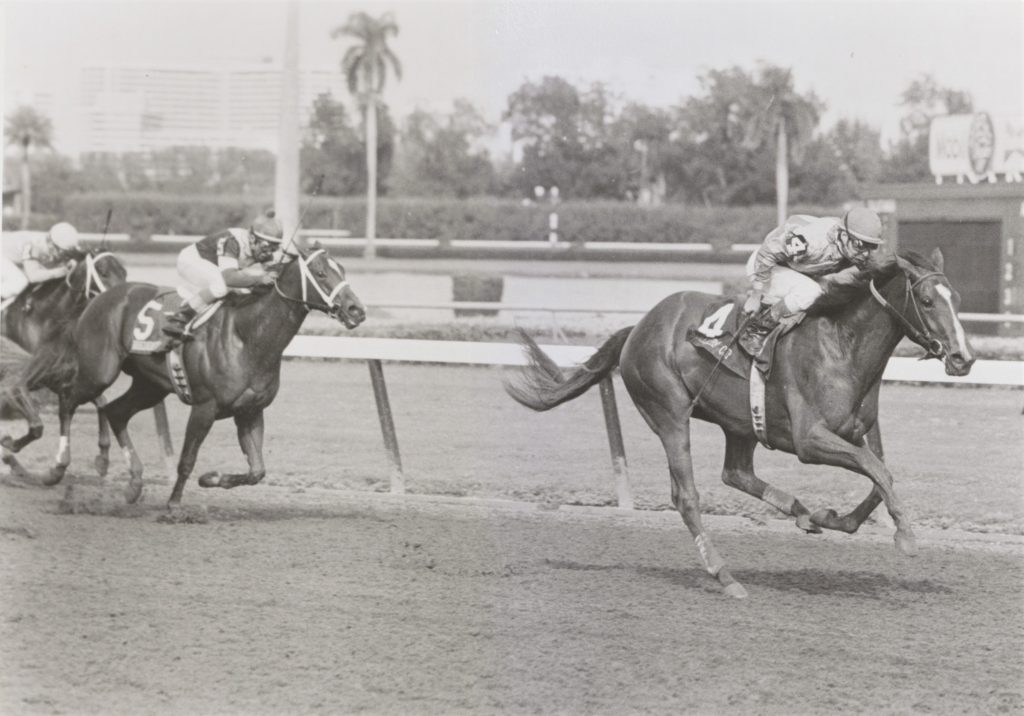
“It wasn’t her tragic death that meant so much. It was her joy of racing.”
–Jane du Pont Lunger
By Jennifer Kelly
In the mind’s eye, she is forever in flight, four feet off the ground, her rider motionless on her back. Heartbroken, we think of the end, unfathomable and real, memories that cut to the heart. In that instant, she shines with promise, and, in the next, fades with a click. For all the grief that her end brought, the horse that she was leaves her eternally etched on the heart. She was magic. She was Go for Wand.
To Cast a Spell
Jane du Pont Lunger was a member of the distinguished du Pont family, a philanthropist, and allergic to horses. That didn’t keep her from owning and breeding Thoroughbreds for almost seven decades, her Christiana Stable racing champions like Thinking Cap, who won both the Travers Stakes and Lawrence Realization in 1955; Endine, twice a winner of the Delaware Handicap; and Obeah, a daughter of their Dwyer Handicap winner Cyane. Racing in the Christiana purple and yellow, Obeah would win the Delaware Handicap twice, in 1969 and 1970, and then finish second in the Beldame and Diana Stakes, amassing $387,299 in purses during her years on the track. As a broodmare, she produced several foals by Northern Dancer, including some stakes winners, but Lunger took a chance on her mare, who was reaching the end of her broodmare career at age twenty-one, and opted to pair her with another Canadian champion, Deputy Minister.
Deputy Minister was so good at age two that he won both Canadian Horse of the Year and the Eclipse Award winner for best two-year-old in the United States. Victories in races like the Laurel Futurity and the Youthful Stakes augured well for Deputy Minister at three, but an injury prevented him from racing that season. He did come back at age four to win the Donn Handicap and the Tom Fool Stakes before retiring to stud. As a sire, he produced horses like 1989 Kentucky Oaks winner Open Mind, 1998 Breeder’s Cup Classic winner Awesome Again, and 1997 Belmont Stakes winner Touch Gold. He was a stallion that produced quality horses, a logical choice for a mare like Obeah.
Despite her advanced age, Obeah’s pairing with Deputy Minister produced a gorgeous bay filly with an almost wand-like stripe of white down her lovely face. “There was something so special about her,” Richard Jones, Lunger’s son-in-law and stable manager said of Obeah’s filly. Playing off her dam’s name, Joan Lunger would christen her Go for Wand.
A Girl Named Wanda
Billy Badgett had learned the training game under greats like Woody Stephens, spending five years during Stephens’s decade of dominance as an assistant trainer. When Badgett went out on his own, Stephens helped him get both horses and contacts, including Claiborne Farm’s Seth Hancock. That connection helped Badgett land two big owners, Greentree and Christiana Stables. His partnership with Jane du Pont Lunger and Christiana Stables would bring Badgett a chance for his greatest triumphs and heartbreak. Still relatively new as a trainer, this lifelong horseman knew greatness – he has been around Stephens’s barn when Swale won the Kentucky Derby and then the Belmont Stakes – and when Go for Wand arrived in his barn, he knew he had something special. The filly’s gentle nature and eagerness to please the humans around her winning the hearts of both Badgett and his exercise rider/future spouse Rose Mundy. After a strong five-furlong workout at Saratoga, Go for Wand also won the heart of jockey Randy Romero, the only rider the filly would ever know.
Lunger preferred to bring her two-year-olds along slowly, so Badgett was in no hurry to bring Go for Wand to the races. She made her first start at Belmont Park in mid-September 1989, winning her first race by four lengths, running the six furlongs in 1:10 3/5. She followed that up with a one-mile allowance race in early October, winning by eighteen and a quarter lengths over a sloppy track. Both performances demonstrated that this filly had the potential to be a one-in-a-lifetime horse. Badgett would test that in the Frizette Stakes.
Go for Wand met Stella Madrid, winner of three straight stakes races, on a dry and cuppy Belmont track for the one-mile Frizette. After stumbling at the start, Stella Madrid grabbed the lead and held it for much of the race, while Go for Wand struggled over the loose track. Wanda made a late run at Stella Madrid in the stretch, cutting her lead down to a half-length at the wire. That second-place finish would be Go for Wand’s lone loss of 1989.
That close second was impressive enough that Badgett thought she belonged in the Breeder’s Cup Juvenile Fillies, where she faced Stella Madrid and Selima Stakes winner Sweet Roberta. Go for Wand stumbled a bit on the first turn, but Romero was able to steady her and set her down for the mile and a sixteenth race. She ran in sixth, with Special Happening and Stella Madrid on the lead. As the field swung into the final turn, Special Happening still held a short lead, but, behind her, the late runners were gearing up for the stretch run. Romero gave Go for Wand the signal to go, moving up and picking off horses, as Stella Madrid too the leading from Special Happening. To her outside, though, Go for Wand was in full stride, swallowing up the gap between them and then passing Stella Madrid with the wire looming. In the race’s waning strides, her speed had carried her to victory by almost three lengths. Go for Wand earned the Eclipse Award for champion two-year-old filly despite her late start to her first season of racing.

At two, this daughter of Deputy Minister had been special, but, at three, she was brilliant. In her season debut in the Beaumont at Keeneland, she romped in the mud to win by eight lengths. She followed that with a four-length victory in the Ashland Stakes before going to Churchill Downs to run in the Kentucky Oaks. Finishing second behind Seaside Attraction, the Oaks marked her second defeat of her short career, as another loose and cuppy track kept her from running her race. Go for Wand would win five more stakes races in 1990, including the Mother Goose, the Test, the Alabama, and the Beldame Stakes.
In the mile and a quarter Alabama at Saratoga, Go for Wand faced only two horses, including Charon, winner of the Coaching Club American Oaks and the Black-Eyed Susan Stakes. Go for Wand led easily throughout the race, leaving Charon far behind when they hit the stretch. In doing so, Lunger’s filly set a stakes record, 2:00 4/5, for the ten furlongs. With that win, Go for Wand made a case for Horse of the Year.
Billy Badgett and his new bride Rose had their filly primed for the race they had been pointing for the whole season: the Breeder’s Cup Distaff. He thought for a moment about running her in the Classic, but Lunger did not like running her fillies against colts. The Distaff it was. On racing’s biggest stage, Go for Wand was ready to shine.
Instead, it was all about to come crashing down.
Heartbreaking Heroine
Of the seven races on the Breeder’s Cup card in 1990, the Distaff was one of the most anticipated contests of the year. Seven fillies and mares, each stakes winners and arguably the leading female horses in the country, went to the gate for the mile and an eighth race, but the eyes of all at Belmont Park were on two horses: Bayakoa and Go for Wand. This was expected to be a duel, a battle for the top female horse of 1990. Wanda had a titanic task ahead of her.
Bayakoa had started her career in her native Argentina, but came to the United States at age four, after Frank and Janis Whitham purchased her on the recommendation of trainer Ron McAnally. She quickly established herself as one of the best female horses in the country, winning eight stakes races in 1989, including the Breeder’s Cup Distaff. After being named the Champion Older Female for that year, she returned in 1990 to do more of the same winning six stakes races and running second to Quiet American in the San Diego Handicap. Facing Bayakoa in the Distaff would be among Go for Wand’s greatest tests.
It would also be her last.
In the Distaff, Go for Wand broke well from the middle of the field, Romero guiding her to the rail. Bayakoa and Laffit Pincay, Jr. joined them, the two champions head to head, nose to nose. They ran that way down the backstretch and around that final turn, Bayakoa locked in battle with Go for Wand. As they entered the stretch, still eye to eye, Romero felt like his filly had something left. She had enough to finish and to outlast the mare next to her. With only a sixteenth of a mile to go, though, catastrophe: Go for Wand’s cannon bone shattered.
In reality, watching it played out live on television or at a packed Belmont Park, she tumbled to the track in a fraction of a second, Romero thrown over her head. In our memories, though, like Ruffian before her and Barbaro since, the tragedy lingers. All that she was falls away, replaced by what she could have been, what she should have been.
That is why we remember her, Ruffian, Barbaro, any horse that is taken from us suddenly. We think of the coulds and the shoulds and we mourn. But time passes and we think more of what they were, why we loved them, rather than lament the moments we didn’t have.
Forever Enlightened
In the thirty years since that day at Belmont Park, Go for Wand’s short life has touched the industry and the people who loved her in many ways. Billy and Rose Badgett went on to have a family, their three children growing up with remembrances of Wanda and other horses that Badgett trained. Mrs. Lunger would continue to race and breed, making Saratoga one of her destinations each year. Go for Wand would be laid to rest there, in the infield at the racetrack where she had some of her greatest performances, and then, in 1996, would be enshrined in the National Museum of Racing and Hall of Fame. Randy Romero would recover from the injuries he sustained when Go for Wand fell and continue to ride, retiring in 1999. He would join his superstar filly in the Hall of Fame in 2010 before passing away last year.
Aside from the impact she had on those closest to her, Go for Wand’s fall prompted the American Association of Equine Practitioners to institute the On Call program. This injury management program has specialized medical equipment stationed around the racetrack and veterinarians on hand to both assist injured horses and explain these injuries to the press on big race days like the Breeder’s Cup.
Go for Wand’s short life had a lasting impact, as she wowed fans with her dazzling performances as well as her grit and determination. As we think on the decades that have passed, let’s remember her at her best, gracefully striding out in flight, and be thankful for the chance to honor her life as we celebrate those who have come after her.
All Photos used in this article are property of “Keeneland Library Thoroughbred Times Collection” “These images are protected by copyright and may not be reproduced in print or electronically without written permission of the Keeneland Library.”


